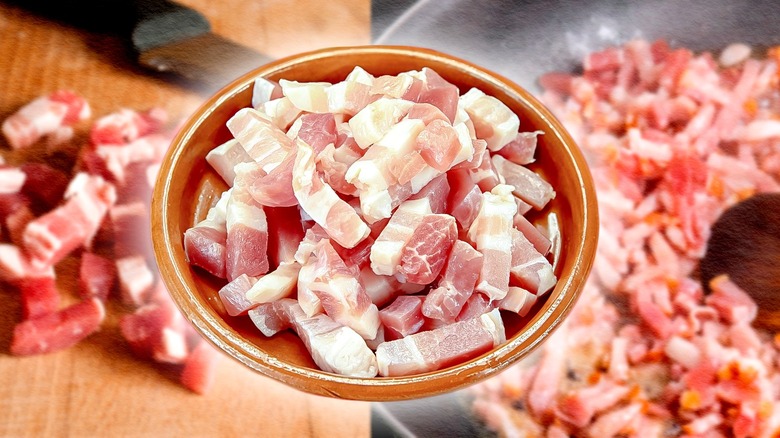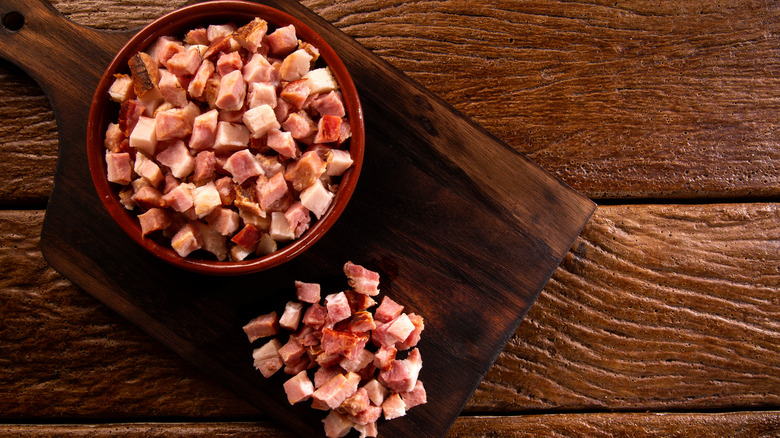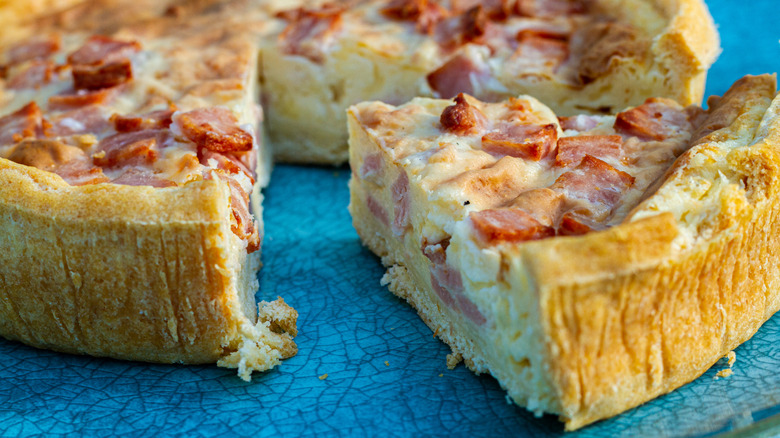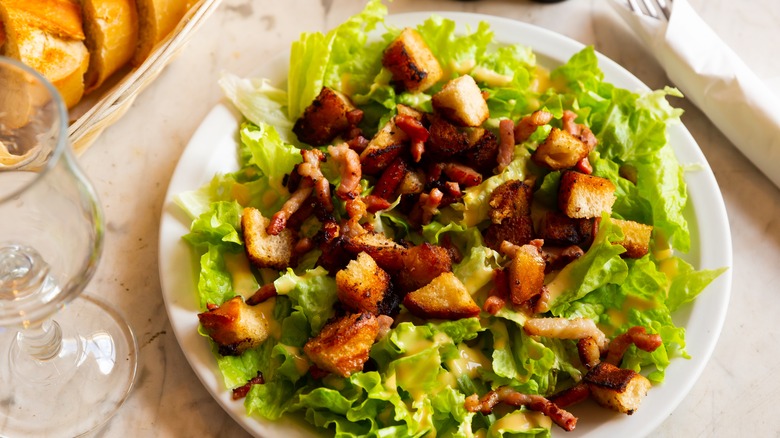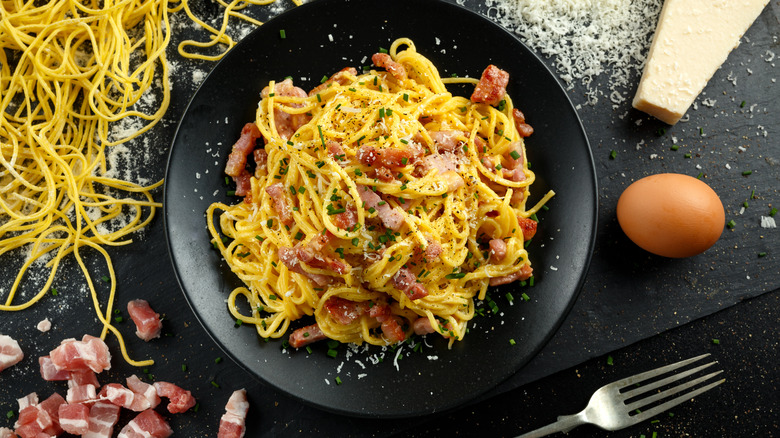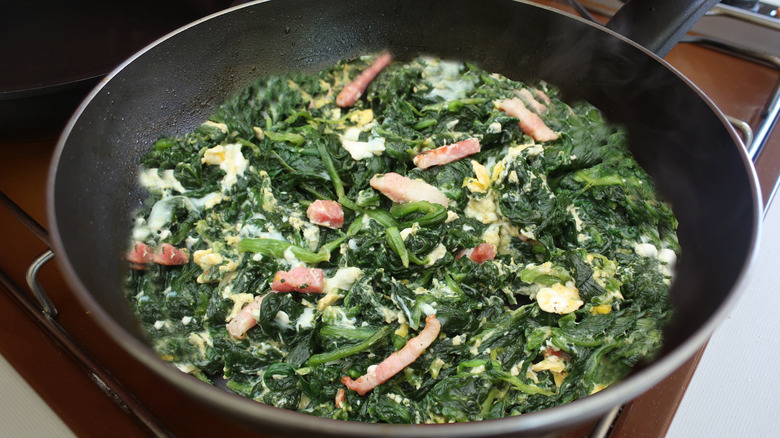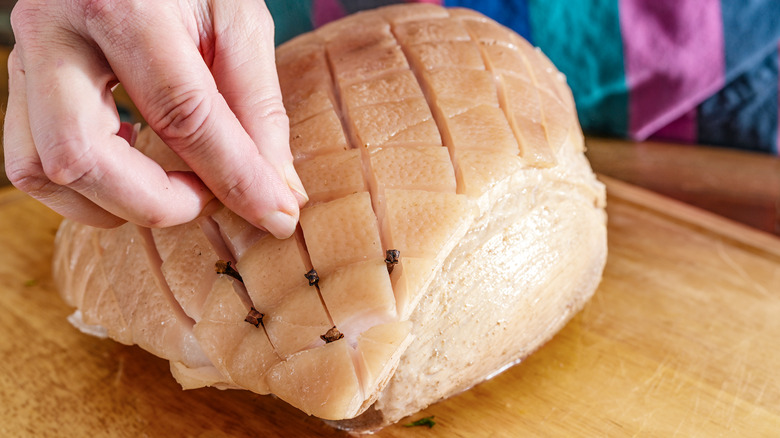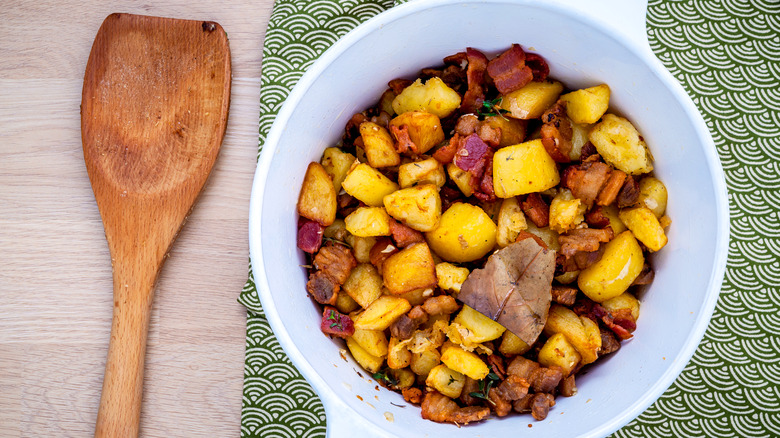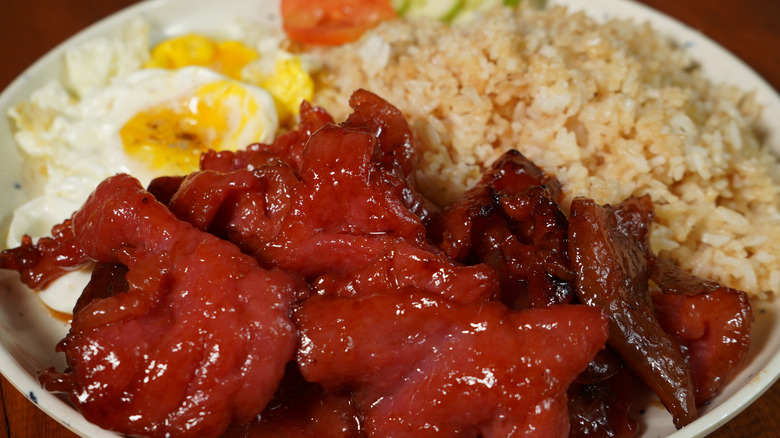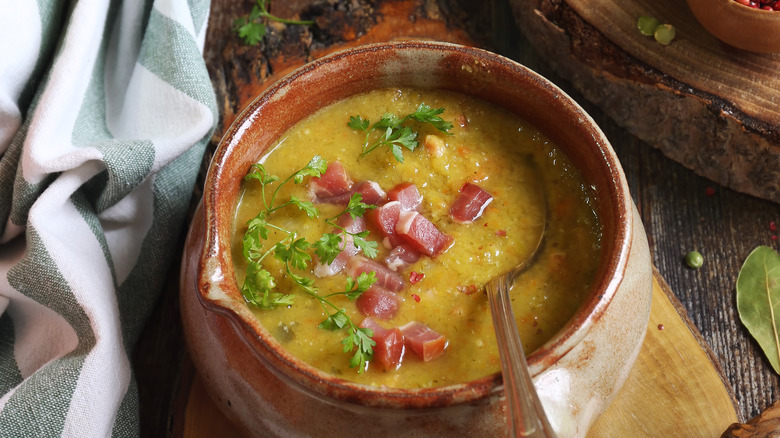What Are Lardons And How Are They Used To Build Flavor In Dishes?
Next time you're contemplating sprinkling crumbled bacon over your potato, salad, or pasta dish, consider swapping them for their French alternative, lardons. Not only are lardons an essential French cooking term, but unlike traditional bacon, lardons are thicker, juicier, and always chopped into small pieces. Not only do lardons create additional layers of crispy, meaty texture to your meal that you won't get from normal bacon, but they also add a mouthwatering savory, salty, and slightly smokey flavor.
While the exact history of lardons is unknown, lardons have been used to build flavor for centuries; the first known use of lardons dates back to the 14th century. While the name comes from "to lard," a process of adding moisture to meats, nowadays, lardons are an ingredient that can be found not only in French cooking but across the world. Hopefully, it will soon be found in your kitchen, as well.
What are lardons?
With a crispy exterior and a tender inside, lardons are a step up from simply garnishing with bacon bits. Made with either uncured pork fat or salt-cured pork, and cut into matchsticks or cubes, lardons add a bit of a crunch along with a salty, rich flavor.
Lardons are the perfect flavorful addition to anything from omelets, quiches, soups, or vegetables. Because of their high-fat content, lardons are highly versatile when it comes to building flavor in dishes; not only do they complement meat-based entrees like roasts or stews (whose long cooking process would likely cause standard bacon to become too dry), but they can also add flavor and dimension to dishes that would be otherwise bland like pasta or potato dishes, or anything that could just use a bit of saltiness or heartiness. Even the fat rendered during the cooking process can be used for flavoring and can amplify the richness of meat or sautéed vegetables.
How are lardons made?
Lardons come from slab bacon, which is the whole smoked pork belly prior to being sliced into bacon strips. From there, the slab bacon is cut into small pieces. If doing it yourself, just make sure to not cut the pieces too small, as the lardons will shrink a bit during the cooking process.
Like bacon, lardons are quite simple to cook. Firstly, try to arrange the pieces in a skillet so that they are not touching, ensuring a more even frying process, and start with a cold frying pan, allowing the lardons to cook slowly. From there, simply sauté on medium heat with a bit of oil and cook gently, stirring occasionally so that each piece browns evenly. Having patience is key, but you want to avoid overcooking, instead achieving that perfectly crispy outer layer with a tender, juicy inside. Once each piece is crisp and golden, remove the lardons with a slotted spoon and drain on a paper-towel-lined plate briefly before digging in.
Bacon vs. lardon
Although the two can often be used interchangeably to beef up a meal's texture and depth, unlike bacon, lardons are traditionally not smoked, although there can be some exceptions to this. There is also a key textural difference between the two, as an integral characteristic of lardons is that they are cut from slab bacon into about ¼ inch pieces, which contain both fat and lean layers of meat. While bacon can certainly be crumbled into small pieces, it is by no means a requirement, but when it is crumbled, it is more likely to be only crispy, without the tender insides found when enjoying lardons.
For this reason, you're unlikely to want to switch up your bacon for lardon on a BLT on a burger. But any time you want to add a bit of crispness and are looking for something meatier than typical bacon, lardon is a worthy substitute.
What do lardons taste like?
There's a reason that lardons are considered to be a French cooking staple. Not only are they incredibly versatile, but a little goes a long way when enhancing flavor, making them an economical method for taking your cooking up a notch. Lardons can contribute a savory, rich, and flavorful element to a number of meals and sides. Not only do they boost the salty quality of a number of dishes, but traditional lardons also offer just a hint of smokiness, as the pork is salt-cured, of course, this particular flavor will be enhanced if you wind up with the smoked variety.
Lardons can not only pull together the flavors of the rest of the dish, but they create the perfect contrast to the bitterness of vegetables while balancing out the flavors of quiches or frittatas. They can even boost the flavors in chicken or beef dishes that normally wouldn't include bacon or lardon in the original recipes.
How to cook with lardons
The beauty of lardons is their versatility. When topping hot dishes like Tartiflette (a cheesy French potato dish you should definitely try) with lardons, make sure to garnish at the end of the cooking process so that they remain crisp. Because of their high-fat content, you want to prevent your dishes from becoming greasy, so remember to remove the lardons from the fat before combining them with the rest of the meal. However, this doesn't mean you should waste the fat. In fact, it means just the opposite — any fat rendered during the cooking process will work as a delicious substitute for oil or butter in another dish, so don't forget to save it.
Use both the lardons as well as the rendered fat in recipes like bacon fat hash browns, or stick with the French-inspired food theme and substitute ham for lardons in this creamy ham and potatoes au gratin recipe. Lardons also add the perfect textural element and saltiness to a classic French bistro salad.
What is larding?
If you've ever ended up with a pot roast or veal that's too lean or dry, you may want to consider larding your meat next time for a boost of moisture and flavor. Lardons are perfect for this process — in fact, historically, they were used in France for exactly this use.
Although larding isn't as popular nowadays, it's still a trick that can come in handy. All you'll need is a larding needle, which is used to insert the lardons into the meat, infusing it with moisture and flavor. Put the lardons in the freezer before adding them to the meat, as this will make the insertion process easier, and if you want to ensure even more flavor gets layered into the meat, try coating the lardons in chopped spices or herbs, or inserting garlic cloves to the meat as well. To avoid cooking dry veal, you can even just cut slits into the sides and insert the lardon there.
Where to buy lardons
Lardons can sometimes be found in grocery stores such as Whole Foods Market or Wegmans (try checking the butcher or deli counters if they're not near the prepackaged bacon), but your best bet may be stopping by your local butcher. Finding pre-cut lardons may be a bit more difficult, but it takes little effort to slice the meat into matchsticks yourself. If you are able to find pre-cut lardons, ensure that you're selecting the right-sized lardons for your dish, although if they're larger pieces, they can always be cut down into smaller pieces to avoid overwhelming your meal. If you're unable to track any lardons down locally, they can be found online, at sellers such as Old Major Artisinal Meats + Provisions, Piper Farms or Butcher Girls.
But if you're really in a pinch and can't wait for a delivery, you can always use thick-cut bacon instead. Pancetta, an Italian style of curing pork belly, would also work as a great substitute.
Nutritional information about lardons
Like bacon, lardons are high in sodium, cholesterol, and saturated fat, which can increase the risk of heart disease. Processed meats, bacon and lardons contain additives like nitrates and nitrites, which when cooked at high temperatures, form compounds called nitrosamines, which are carcinogens.
Although it's generally advised to enjoy lardon and bacon in moderation, the news isn't all bad — both lardons and bacon are a source of protein, and have some beneficial vitamins and minerals such as B vitamins and choline, which improve brain health. Although bacon is relatively lower in vitamins and minerals than other sources of meat, it does contain iron, magnesium, zinc, and potassium. Bacon and lardons also have high salt content, which has been linked to heightened blood pressure and an increased risk of stomach cancer, although it may also be beneficial for people who could be deficient in electrolytes, such as athletes.
Varieties of lardons
Versions of lardons have popped up around the world — the Caribbean take on lardons, known as "tocino" (Spanish for "bacon"), is pork fatback that is fried until crispy, and can be found in staples such as mofongo. Tocino is also an essential ingredient in Filipino cuisine, and is often marinated with sugar and garlic, and typically served with the classic Filipino breakfast dish tocilog, which features garlic rice and a sunny-side-up egg alongside it.
You'll also find that the uses of lardons vary throughout the world, and they can be adapted for usage in a number of popular international dishes. In the United Kingdom for instance, it's not uncommon to spot them in classics like bangers and mash and full English breakfasts, while in Spain, they can be found in various tapas or paellas. While in Italy, pancetta is more commonly found, it is quite similar to lardons, Essentially Italian bacon, pancetta is an ideal option for pastas like carbonara, and can often be used interchangeably with bacon and lardons.
How to store lardons
Cooked bacon or lardons can stay fresh in the refrigerator for around five days, or can be kept at room temperature in a tightly sealed container for around a day. To reheat, simply cook at low heat over the stove or in the oven.
To store an uncooked but opened package of bacon or lardons, remove the meat from the original packaging tightly wrap the bacon in plastic wrap and then aluminum foil, and then place it in a ziploc bag. This should keep the bacon fresh for another five days or so. When you're ready to cook the bacon or lardons, check for any sour scent, slimy texture, or grayish, brownish, or even green coloring, and discard it if so. An unopened package can be kept safely in the refrigerator for around two weeks or until the expiration date. If unopened, bacon can also be kept frozen for three or four months. When ready to use, just place the bacon in the refrigerator overnight beforehand.
